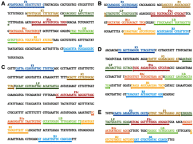Multiplex loop-mediated isothermal amplification (multi-LAMP) assay for rapid detection of mcr-1 to mcr-5 in colistin-resistant bacteria
- PMID: 31308708
- PMCID: PMC6613457
- DOI: 10.2147/IDR.S210226
Multiplex loop-mediated isothermal amplification (multi-LAMP) assay for rapid detection of mcr-1 to mcr-5 in colistin-resistant bacteria
Abstract
Purpose: The discovery of the plasmid-mediated colistin resistance genes, mcr, revealed a mechanism of transmission of colistin resistance, which is a major, global public health concern especially among individuals infected with carbapenem-resistant Gram-negative bacteria. To monitor the spread and epidemiology of mcr genes, a convenient and reliable method to detect mcr genes in clinical isolates is needed, especially in the primary care institutions. This study aimed to establish a restriction endonuclease-based multiplex loop-mediated isothermal amplification (multi-LAMP) assay to detect mcr genes (mcr-1 to mcr-5) harbored by colistin-resistant bacteria. Methods: A triple-LAMP assay for mcr-1, mcr-3, and mcr-4 and a double-LAMP assay for mcr-2 and mcr-5 were established. The sensitivity and specificity of the LAMP reactions were determined via electrophoresis and visual detection. Results: The sensitivity of the LAMP assay was 10-fold greater than that of PCR, with high specificity among the screened primers. Specific mcr genes were distinguished in accordance with band numbers and the fragment length of the digested LAMP amplification products. Furthermore, the LAMP assay was confirmed as a rapid and reliable diagnostic technique upon application for clinical samples, and the results were consistent with those of conventional PCR assay. Conclusion: The multi-LAMP assay is a potentially promising method to detect mcr genes and will, if implemented, help prevent infections by drug-resistant bacteria in primary-care hospitals due to rapid and reliable surveillance. To our knowledge, this is the first study to report the application of LAMP to detect mcr-2 to mcr-5 genes and the first time that multi-LAMP has been applied to detect mcr genes.
Keywords: colistin resistance; enzyme digestion; mcr genes; multi-LAMP; rapid detection.
Conflict of interest statement
The authors report no conflicts of interest in this work.
Figures




Similar articles
-
Sensitive and Rapid Detection of the Plasmid-Encoded Colistin-Resistance Gene mcr-1 in Enterobacteriaceae Isolates by Loop-Mediated Isothermal Amplification.Front Microbiol. 2017 Nov 29;8:2356. doi: 10.3389/fmicb.2017.02356. eCollection 2017. Front Microbiol. 2017. PMID: 29238331 Free PMC article.
-
Rapid and Sensitive Detection of the Colistin Resistance Gene mcr-3 by Loop-Mediated Isothermal Amplification and Visual Inspection.Microb Drug Resist. 2021 Oct;27(10):1328-1335. doi: 10.1089/mdr.2020.0129. Epub 2021 Jul 14. Microb Drug Resist. 2021. PMID: 34264742
-
Development and validation of a multiplex polymerase chain reaction assay for detection of the five families of plasmid-encoded colistin resistance.Int J Antimicrob Agents. 2019 Mar;53(3):302-309. doi: 10.1016/j.ijantimicag.2018.10.022. Epub 2018 Nov 3. Int J Antimicrob Agents. 2019. PMID: 30395987
-
Rapid Detection of Mobilized Colistin Resistance using a Nucleic Acid Based Lab-on-a-Chip Diagnostic System.Sci Rep. 2020 May 21;10(1):8448. doi: 10.1038/s41598-020-64612-1. Sci Rep. 2020. PMID: 32439986 Free PMC article.
-
Current and Future Advances in the Detection and Surveillance of Biosecurity-Relevant Equine Bacterial Diseases Using Loop-Mediated Isothermal Amplification (LAMP).Animals (Basel). 2023 Aug 18;13(16):2663. doi: 10.3390/ani13162663. Animals (Basel). 2023. PMID: 37627456 Free PMC article. Review.
Cited by
-
A Review on Colistin Resistance: An Antibiotic of Last Resort.Microorganisms. 2024 Apr 11;12(4):772. doi: 10.3390/microorganisms12040772. Microorganisms. 2024. PMID: 38674716 Free PMC article. Review.
-
Rapid detection of a novel B1-β-lactamase gene, blaAFM-1 using a loop-mediated isothermal amplification (LAMP) assay.Ann Clin Microbiol Antimicrob. 2021 Dec 7;20(1):80. doi: 10.1186/s12941-021-00486-z. Ann Clin Microbiol Antimicrob. 2021. PMID: 34876146 Free PMC article.
-
Single-channel digital LAMP multiplexing using amplification curve analysis.Sens Diagn. 2022;1(3):465-468. doi: 10.1039/d2sd00038e. Sens Diagn. 2022. PMID: 37034965 Free PMC article.
-
Recent advances in loop-mediated isothermal amplification (LAMP) for rapid and efficient detection of pathogens.Curr Res Microb Sci. 2022 Feb 23;3:100120. doi: 10.1016/j.crmicr.2022.100120. eCollection 2022. Curr Res Microb Sci. 2022. PMID: 35909594 Free PMC article. Review.
-
Bacteriophage as a Novel Therapeutic Weapon for Killing Colistin-Resistant Multi-Drug-Resistant and Extensively Drug-Resistant Gram-Negative Bacteria.Curr Microbiol. 2021 Dec;78(12):4023-4036. doi: 10.1007/s00284-021-02662-y. Epub 2021 Oct 11. Curr Microbiol. 2021. PMID: 34633487 Free PMC article. Review.
References
-
- Centers for Disease Control and Prevention. Antibiotic resistance threats in the United States; 2013. Available from: https://www.cdc.gov/drugresistance/pdf/ar-threats.
LinkOut - more resources
Full Text Sources

